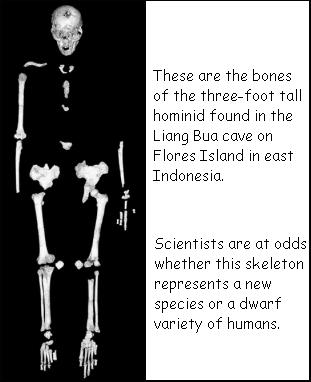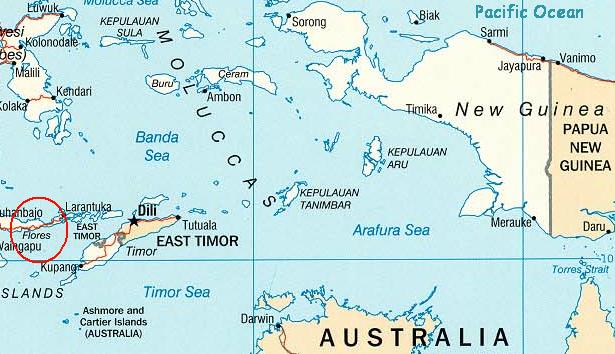Paleoanthropologists at Work
by
Warren F. O'Rourke


 Here's one example of how evolutionary scientists really work:
Here's one example of how evolutionary scientists really work:
 In 2003 Australian paleoanthropologists were excavating a cave on the Indonesian island of Flores when they discovered some not yet quite fossilized hominin remains. (In most current scientific literature on human evolution the term hominin has replaced the term hominid as a name for all modern humans, their extinct ancestors, and other quite human-like beings such as australopithicus who may or may not have been directly ancestral to modern man.)
In 2003 Australian paleoanthropologists were excavating a cave on the Indonesian island of Flores when they discovered some not yet quite fossilized hominin remains. (In most current scientific literature on human evolution the term hominin has replaced the term hominid as a name for all modern humans, their extinct ancestors, and other quite human-like beings such as australopithicus who may or may not have been directly ancestral to modern man.)
 After a year of studying these skeletal remains, the Aussie scientists began publishing their initial findings and conjectures in various respectable, peer-reviewed journals. The initial journal article appeared in 2004 and presented such info as estimated age, physical measurements, other descriptive anatomical information about the original find as well as subsequent finds, and the scientists' initial arguments for the hypothesis that all these remains belonged to a previously unknown species of hominin that lived at the same time as our own species, Homo sapiens. And, of course, the authors of the article claimed their traditional right to name the new species. They named him (or her) Homo floresiensis, or "man of Flores," a very correct but boring scientific name for a very human-looking character with a head only slightly larger than a softball.
After a year of studying these skeletal remains, the Aussie scientists began publishing their initial findings and conjectures in various respectable, peer-reviewed journals. The initial journal article appeared in 2004 and presented such info as estimated age, physical measurements, other descriptive anatomical information about the original find as well as subsequent finds, and the scientists' initial arguments for the hypothesis that all these remains belonged to a previously unknown species of hominin that lived at the same time as our own species, Homo sapiens. And, of course, the authors of the article claimed their traditional right to name the new species. They named him (or her) Homo floresiensis, or "man of Flores," a very correct but boring scientific name for a very human-looking character with a head only slightly larger than a softball.

 Yes, boring! What this new find needed was a sexy name to spur the interest of the science journalists and the general public as well as the people who fund paleoanthropological expeditions to out of the way places like the tiny Indonesian island about a 1,000 miles west of New Guinea and about 800 miles northwest of Darwin, Australia. So the Aussie scientists followed the 1974 example of Don Johanssen and Tom Gray who nicknamed their newly discovered Australopithicus afarensis skeleton for an immensely popular Beatles song that was played over and over at the party celebrating the discovery: "Lucy in the Sky with Diamonds." Thanks in part to the fame of the Beatles, Lucy soon became the most well-known hominin fossil in the world.
Yes, boring! What this new find needed was a sexy name to spur the interest of the science journalists and the general public as well as the people who fund paleoanthropological expeditions to out of the way places like the tiny Indonesian island about a 1,000 miles west of New Guinea and about 800 miles northwest of Darwin, Australia. So the Aussie scientists followed the 1974 example of Don Johanssen and Tom Gray who nicknamed their newly discovered Australopithicus afarensis skeleton for an immensely popular Beatles song that was played over and over at the party celebrating the discovery: "Lucy in the Sky with Diamonds." Thanks in part to the fame of the Beatles, Lucy soon became the most well-known hominin fossil in the world.

 The Beatles were hot in 1974; The Lord of the Rings was hot in in the early 2000's, especially with Australians and New Zealanders since the three parts of the trilogy were shot in New Zealand and brought millions of pounds into the economies of New Zealand and Australia. Thus it was that Australian workers at the excavation site on Flores Island noted that the 3-foot tall creatures with big feet which they had discovered resembled the Hobbits as described by Tolkien, and from there they started calling these creatures Hobbits as a nickname. That got both the scientists and the larger world interested in this discovery. It also got the experts arguing over the nature of the find.
The Beatles were hot in 1974; The Lord of the Rings was hot in in the early 2000's, especially with Australians and New Zealanders since the three parts of the trilogy were shot in New Zealand and brought millions of pounds into the economies of New Zealand and Australia. Thus it was that Australian workers at the excavation site on Flores Island noted that the 3-foot tall creatures with big feet which they had discovered resembled the Hobbits as described by Tolkien, and from there they started calling these creatures Hobbits as a nickname. That got both the scientists and the larger world interested in this discovery. It also got the experts arguing over the nature of the find.
 The facts that fossilization of the remains is incomplete and that the geological age of the Indonesian cave is pretty well known -- both these facts support a very "young" estimate of about 12,000 years for the youngest of these remains and perhaps 90,000 years for the oldest. Modern humans, who appeared at least 200,000 years ago, were already present on earth at that same period. Nobody disagrees about that.
The facts that fossilization of the remains is incomplete and that the geological age of the Indonesian cave is pretty well known -- both these facts support a very "young" estimate of about 12,000 years for the youngest of these remains and perhaps 90,000 years for the oldest. Modern humans, who appeared at least 200,000 years ago, were already present on earth at that same period. Nobody disagrees about that.
 So either (a) the "hobbits" were a never-before-discovered and separate species distinct from Homo sapiens or (b) the "hobbits" were some sort of racial or deformed variation of modern human beings. If (a) is true, then Homo floresiensis is as important as Neanderthal Man (who also co-existed with Homo sapiens)and all the textbooks will have to be re-written and the relationships between the various hominins will have to be re-evaluated and dozens of would-be paleoanthropologists will find themselves with Ph.D. dissertation topics on minor points concerning the Indonesian cave discoveries and some people who are considered experts today will lose status and the Aussie scientists will become the new heroes of human evolutionary study; if (b) is true then the Aussie scientists and their supporters will end up looking almost as wrong-headed as the guy who perpetrated the the Piltdown Man forgery.
So either (a) the "hobbits" were a never-before-discovered and separate species distinct from Homo sapiens or (b) the "hobbits" were some sort of racial or deformed variation of modern human beings. If (a) is true, then Homo floresiensis is as important as Neanderthal Man (who also co-existed with Homo sapiens)and all the textbooks will have to be re-written and the relationships between the various hominins will have to be re-evaluated and dozens of would-be paleoanthropologists will find themselves with Ph.D. dissertation topics on minor points concerning the Indonesian cave discoveries and some people who are considered experts today will lose status and the Aussie scientists will become the new heroes of human evolutionary study; if (b) is true then the Aussie scientists and their supporters will end up looking almost as wrong-headed as the guy who perpetrated the the Piltdown Man forgery.
 There is a lot at stake: reputations; careers, promotions, and research and teaching positions at the most prestigious and respected universities; funding; and -- incidentally -- the advancement of knowledge.
There is a lot at stake: reputations; careers, promotions, and research and teaching positions at the most prestigious and respected universities; funding; and -- incidentally -- the advancement of knowledge.
 And now the war between the two sides is being waged in the peer-reviewed journals. The Aussie scientists and their supporters like Dr. Dean Falk at Florida State University publish serious and compelling articles about anatomical similarities and differences and about brain-case measurements and about the pint-size stone tools found with the skeletal remains; and all these articles are purportedly evidence that Homo floresiensis is a separate species. (I really like Dean Falk's picture, which makes her look like an adorable, bespectacled, and merry little hobbit woman about 50 years old; and that's the prime of life if you happen to be a hobbit with a life expectancy of about 150 years.)
And now the war between the two sides is being waged in the peer-reviewed journals. The Aussie scientists and their supporters like Dr. Dean Falk at Florida State University publish serious and compelling articles about anatomical similarities and differences and about brain-case measurements and about the pint-size stone tools found with the skeletal remains; and all these articles are purportedly evidence that Homo floresiensis is a separate species. (I really like Dean Falk's picture, which makes her look like an adorable, bespectacled, and merry little hobbit woman about 50 years old; and that's the prime of life if you happen to be a hobbit with a life expectancy of about 150 years.)

 Meanwhile, the opponents present equally serious and compelling articles on such subjects as microencephaly, primordial dwarfism, isolational dwarfism, and the presence of very small humans in the past and in the present on other islands of the eastern Indonesian archipelago. These guys are trying to prove that the Flores cave finds are something like deformed humans, dwarf humans, or maybe even pygmies.
Meanwhile, the opponents present equally serious and compelling articles on such subjects as microencephaly, primordial dwarfism, isolational dwarfism, and the presence of very small humans in the past and in the present on other islands of the eastern Indonesian archipelago. These guys are trying to prove that the Flores cave finds are something like deformed humans, dwarf humans, or maybe even pygmies.
 And so the war of the paleontologists goes on, even including such ad hominem accusations as (a) the original discoverers are preventing their opponents from any further examination the material excavated on Flores and (b) one of the opponents damaged some of the materials when he was allowed to see them.
And so the war of the paleontologists goes on, even including such ad hominem accusations as (a) the original discoverers are preventing their opponents from any further examination the material excavated on Flores and (b) one of the opponents damaged some of the materials when he was allowed to see them.
 So, at the moment, the professionals are divided roughly 50-50 about whether the Flores man is a new species or merely a variant of good old Homo sapiens.
So, at the moment, the professionals are divided roughly 50-50 about whether the Flores man is a new species or merely a variant of good old Homo sapiens.
 I'm hoping Dr. Falk and the Aussies turn out to be correct. Not because I am qualified to evaluate all the articles and evidence, but because Dean Falk would be an appealing guest on the talk shows and a great speaker at professional anthropology meetings and seminars. After all, she might well be a hobbit herself.
I'm hoping Dr. Falk and the Aussies turn out to be correct. Not because I am qualified to evaluate all the articles and evidence, but because Dean Falk would be an appealing guest on the talk shows and a great speaker at professional anthropology meetings and seminars. After all, she might well be a hobbit herself.
Addendum #1: On July 2, 2008, Dr. William Jungers, one of the internationally known anthropologists studying the status of Homo floresiensis, was the guest speaker at the Secret Science Club of New York City. At that Union Hall meeting, Jungers discussed among other things the "Hobbit" skeleton. Evidently this is a very jolly and not really very secret group because all the reports of this meeting mention that the bar was open and that the drink of the evening was called "the Naked Ape," a concoction guaranteed "to strip you bare." (This is not a joke. Apparently it is great fun to be an anthropologist.)
Addendum #2: In all candor, however, I must inform you that these kinds of meetings in Union Hall in Brooklyn piss off the local residents. There have been a number of local protests aimed at canceling the liquor license at Union Hall. Spokesmen for the anti-Union Hall group never argue about what the people there are advocating; all the neighbors want is curb the drunken merry-making that often goes on at Union Hall. Evidently, Brooklynites don't care what you talk about as long as you don't keep them awake at night.
Addendum #3: What is needed to move the floresiensis debate towards a consensus solution is the discovery of more fossils and subfossils on Flores Island and the nearby islands. Unfortunately, the Muslim government of Indonesia is run by fundamentalist Muslims who agree with American Protestant fundamentalists that (a) Darwinism is responsible for most of the world's evils and (b) the universe is only about 7,000 years old. There are more Muslims in Indonesia than anywhere in the world, and it is believed by most (nay, by nearly all) informed people that the government recently has stopped excavation in Liang Bua cave for religious reasons. As far as I have been able to determine, the government of Indonesia has not permitted the paleontologists to do any more digging in the cave.
Addendum #4: In June of 2006, the television show 60 Minutes did a full segment on Homo floresiensis. The narrator mentioned that, although the species went extinct on Flores Island after a volcanic eruption 12,000 years ago, there may well have been more recent populations of floresiensis on some of the other 17,000 islands which make up Indonesia. In fact, the narrator said that some anthropologists linked the Hobbits of Flores with local legends of a three-foot-tall race of humans called abu gogo, which means "grandparents who eat everything in sight," and who are said by the natives to appear suddenly out of the forest, snatch up something to eat, and then disappear like tiny versions of Bigfoot or Sasquatch. Some scientists even suggest that on some of the many islands that are supposedly uninhabited and never fully explored there may even today be remaining populations of floresiensis. Wouldn't that be cool? A new species of humans who at three feet would make modern four-foot pygmies look tall!
Addendum #5: Along with the remains of the hobbits in Liang Bua Cave were tiny tools and tiny weapons that were evidently used to kill the giant rodents, Komodo dragons, and stegodons that made up a large part of the little caveman's diet. A stegodon is an extinct species of dwarf elephant that weighed only a ton, that is, about 2200 pounds. That's tiny for an elephant, but it is still 40 times larger than a 55-pound hobbit! Modern elephants are also about 40 times the size of modern elephant hunters, but -- back when hunting elephants was still cool -- a 195-pound Ernest Hemingway did not go after a four-ton elephant with a stone age spear. No indeed. If you need to kill an elephant today, you use something like a .50 caliber Gibbs elephant gun, available at Abercrombie and Fitch's New York store or from the Gibbs Arms Company for about $6,000. The Gibbs ammo costs about $12 per round. Those little hobbits were much tougher and more foolhardy than modern day elephant hunters.